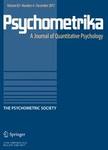版权所有:内蒙古大学图书馆 技术提供:维普资讯• 智图
内蒙古自治区呼和浩特市赛罕区大学西街235号 邮编: 010021

作者机构:Georgia Inst Technol Sch Ind & Syst Engn Atlanta GA 30332 USA Univ Groningen Heymans Inst Psychol Res NL-9700 AB Groningen Netherlands
出 版 物:《PSYCHOMETRIKA》 (心理测量学)
年 卷 期:2000年第65卷第3期
页 面:413-425页
核心收录:
学科分类:0402[教育学-心理学(可授教育学、理学学位)] 04[教育学] 0701[理学-数学]
基 金:National Science Foundation NSF
主 题:asymptotic bias asymptotic normality reliability minimum trace factor analysis large sample theory semidefinite programming
摘 要:In theory, the greatest lower bound (g.l.b.) to reliability is the best possible lower bound to the reliability based on single test administration. Yet the practical use of the g.l.b. has been severely hindered by sampling bias problems. It is well known that the g.l.b. based on small samples (even a sample of one thousand subjects is not generally enough) may severely overestimate the population value, and statistical treatment of the bias has been badly missing. The only results obtained so far are concerned with the asymptotic variance of the g.l.b. and of its numerator (the maximum possible error variance of a test), based on first order derivatives and the asumption of multivariate normality. The present paper extends these results by offering explicit expressions for the second order derivatives. This yields a closed form expression For the asymptotic bias of both the g.l.b, and its numerator, under the assumptions that the rank of the reduced covariance matrix is at or above the Ledermann bound, and that the nonnegativity constraints on the diagonal elements of the matrix of unique variances are inactive. It is also shown that, when the reduced rank is at its highest possible value (i.e., the number of variables minus one), the numerator of the g.l.b. is asymptotically unbiased, and the asymptotic bias of the g.l.b, is negative. The latter results are contrary to common belief, bur apply only to cases where the number of variables is small. The asymptotic results are illustrated by numerical examples.